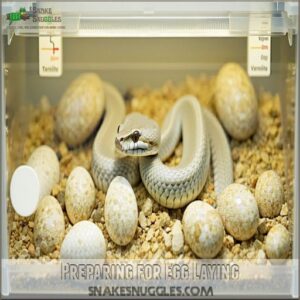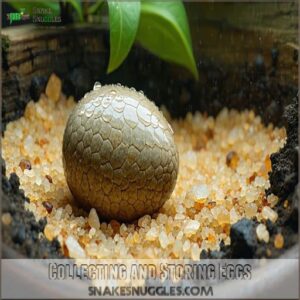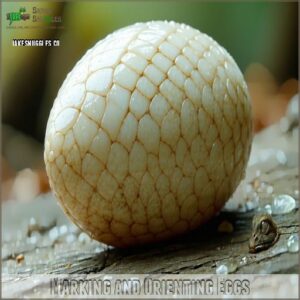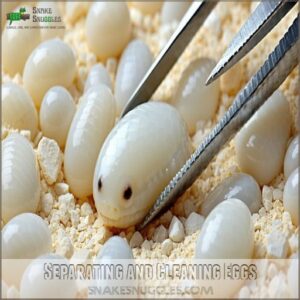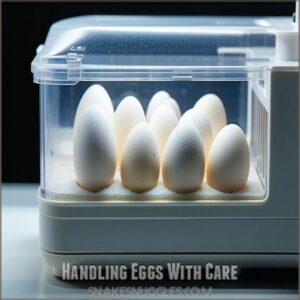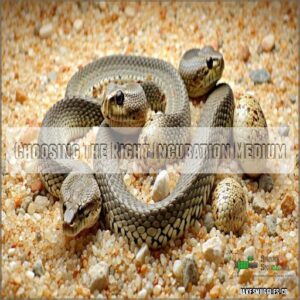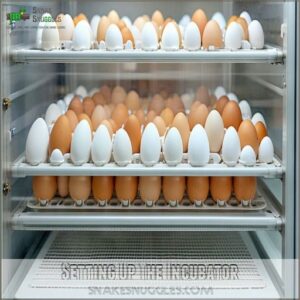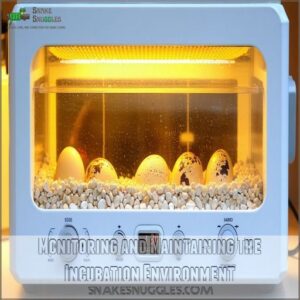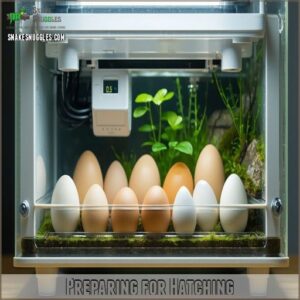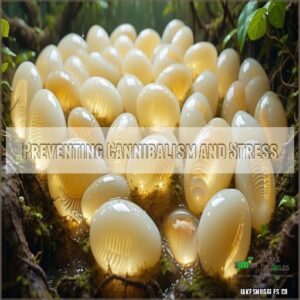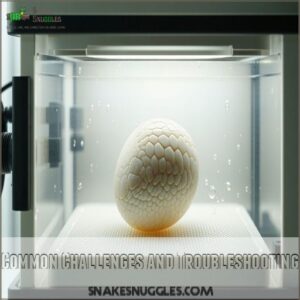This site is supported by our readers. We may earn a commission, at no cost to you, if you purchase through links.
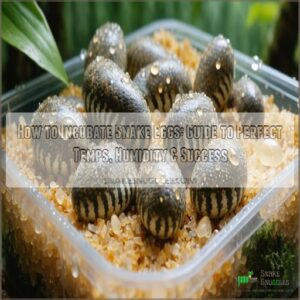
Choose a ventilated container with moistened vermiculite as your incubation medium, maintaining a consistent temperature between 80-85°F.
Keep humidity levels around 85-95% by gently misting with dechlorinated water. Use a digital hygrometer to track conditions precisely, adjusting the water-to-medium ratio as needed.
Handle eggs minimally to prevent damage, and separate any stuck eggs using sterile tools.
Monitor the eggs closely, watching for signs of healthy development and preparing for the exciting moment of hatching.
Table Of Contents
- Key Takeaways
- Preparing for Egg Laying
- Recovering and Handling Eggs
- Choosing The Right Incubation Medium
- Setting Up The Incubator
- Incubation Temperature and Humidity
- Monitoring and Maintaining The Incubation Environment
- Hatching and Post-Hatch Care
- Common Challenges and Troubleshooting
- Frequently Asked Questions (FAQs)
- Can you incubate snake eggs without an incubator?
- How to care for wild snake eggs?
- What temperature do milk snake eggs incubate at?
- What humidity do snake eggs incubate?
- How to identify viable snake eggs?
- What to do if mold develops on eggs?
- How to determine snake egg fertilization?
- Why are snake eggs watery or leaking?
- How to manage infertile snake eggs?
- Can wild snake eggs be successfully incubated?
- Conclusion
Key Takeaways
- Prioritize maintaining consistent temperatures between 80-85°F and humidity levels around 85-95% using a reliable incubator and precise monitoring tools.
- Always mark eggs to maintain their original orientation, handle them carefully, and use a stable medium like moistened vermiculite or perlite.
- Watch for signs of mold, temperature or humidity fluctuations, and egg-bonding issues, acting swiftly to make adjustments or seek expert help.
- Separate hatchlings immediately after hatching to avoid stress or cannibalism, and provide a safe environment with proper temperature and humidity control.
Preparing for Egg Laying
Before your snake lays eggs, you’ll want to make sure she’s healthy and happy.
This means providing a safe, comfortable nesting area.
ensuring proper nutrition and calcium supplementation.
minimizing stress to increase the chances of successful egg-laying and hatching.
Nutrition and Calcium Requirements
Gravid females need a diet that covers calcium supplements and essential nutrients to prevent nutritional deficiencies and support bone health.
Include:
- Calcium-rich foods like pinky mice and rodents.
- Supplement powders to aid calcium absorption.
- Extra calories for energy during egg formation.
- Diverse prey items to enrich the diet.
Proper nutrition guarantees healthy snake egg development and minimizes incubation problems.
Creating a Suitable Egg-Laying Environment
Setting up the right egg-laying spot takes focus.
Use a snug nest box sized for your snake, filled with moist substrate like perlite or vermiculite for proper substrate moisture.
Keep temperatures steady and secure the area with privacy considerations to reduce stress. These security measures guarantee your snake feels safe throughout the snake egg incubation setup.
Monitoring for Egg-Binding
Watching for egg-binding is key to healthy gravid snakes. Look out for a swollen belly or prolonged laying struggles. Act fast if these issues crop up.
Here’s what you can do:
- Recognize symptoms early.
- Try gentle home remedies.
- Seek veterinary care immediately.
Minimizing Stress and Handling
Limit handling to reduce stress and complications.
Provide a quiet environment with a private nesting area. Stick to slow movements for safe transfer. Minimize interference—stress reduction boosts snake egg fertility and supports successful snake egg incubation.
Maintaining a proper temperature range of 80-85°F, which is key for embryo development, also plays an important role in successful incubation.
| Best Practices | Benefits | Examples |
|---|---|---|
| Gentle handling | Reduces potential harm | Minimal, careful handling |
| Private nesting areas | Encourages natural behaviors | Covered boxes with moist substrate |
| Quiet environment | Lowers stress levels | Isolated, low-traffic zones |
| Slow movements | Prevents accidental injury | Smooth, cautious transfers |
| Stress reduction techniques | Promotes successful incubation | Low light, consistent care |
Recovering and Handling Eggs
You’ll need steady hands and careful attention when you’re collecting snake eggs, as these delicate orbs must stay in their original position to keep the developing embryos safe.
Once you’ve found the eggs, you’ll mark their orientation and handle them with extreme care, since any rotation could harm the baby snakes growing inside.
Collecting and Storing Eggs
The moment of egg collection requires swift, precise action to guarantee survival.
Here’s your proven approach:
- Move quickly when eggs appear – waiting even an hour risks cooling
- Place in ventilated containers with damp vermiculite
- Maintain steady temps during transfer
Marking and Orienting Eggs
When handling your freshly collected snake eggs, immediately mark the top with a soft pencil to maintain proper orientation.
Snake egg orientation is essential for embryo development – misalignment can be fatal.
Make small, gentle marks without pressing hard, and keep track of which end was originally facing upward during natural laying.
Separating and Cleaning Eggs
Now that you’ve marked your eggs, separating them properly is your next challenge. Gently detach stuck-together eggs using sterile tools and place them in individual containers.
For hygiene protocols during snake egg incubation, follow these key steps:
- Sterilize your work area with medical-grade disinfectant
- Use clean latex gloves when handling each egg
- Apply antifungal solution sparingly if needed
- Keep eggs in separate, labeled containers
- Maintain strict sanitation methods between handling different clutches
Handling Eggs With Care
Snake egg handling demands a surgeon’s precision. You’ll need to mark the top with a pencil to maintain proper orientation – rotating eggs can harm developing embryos. Handle each egg as if it were made of glass, using clean hands to prevent contamination. A steady touch keeps your future serpents safe.
| Task | Technique | Reminder |
|---|---|---|
| Egg Handling | Gentle touch | They’re fragile treasures! |
| Egg Orientation | Mark top with pencil | Keep orientation steady |
Choosing The Right Incubation Medium
You’ll need the right incubation medium to keep your snake eggs healthy and thriving throughout their development.
A proper medium like perlite or vermiculite creates the perfect environment by maintaining consistent moisture levels and providing essential support for your eggs.
Selecting The Best Materials (Perlite, Vermiculite)
After you’ve collected your eggs, picking the right incubation material makes all the difference.
Perlite and vermiculite are your go-to options, with each bringing something special to the table. Vermiculite’s better at holding moisture, while perlite offers superior drainage.
You’ll want to sterilize either choice before use – a quick bake at 250°F for 30 minutes does the trick.
Both materials are safe for snake eggs and readily available at garden centers.
Avoiding Unsuitable Materials (Sand, Soil, Coconut Husk)
While perlite and vermiculite create ideal conditions.
Common substrates like sand, soil, and coconut husk pose serious risks. These materials trap moisture, leading to bacterial growth and mold issues that can doom your snake eggs before they start developing.
Maintaining The Right Moisture Levels
Proper moisture levels can make or break your snake egg incubation success. You’ll need to monitor substrate moisture with a reliable moisture meter to maintain ideal humidity control throughout the incubation period. Using the right egg incubation substrate is essential for maintaining ideal moisture levels.
- Keep humidity levels between 85-95% by misting with dechlorinated water when needed
- Use a digital hygrometer to track humidity fluctuations
- Place water dishes near ventilation points to create consistent moisture distribution
Remember, different snake species might need slightly different humidity levels for ideal development.
Adjusting The Water-to-Medium Ratio
Getting the water-to-medium ratio right is essential for the best moisture in snake egg incubation.
Mix one part water to one part vermiculite by weight, not volume.
You’ll know you’ve hit the sweet spot when you can squeeze the medium and only a few drops come out.
Test different ratios with your specific incubator setup, as factors like ventilation and humidity levels can affect moisture retention. Snake egg incubation requires the best moisture.
Setting Up The Incubator
You’ll need a reliable incubator with proper ventilation and insulation to create the perfect environment for your snake eggs.
Setting up your incubator correctly is essential, as it’ll maintain the exact temperature and humidity levels your eggs need to develop into healthy snakes. This is crucial for snake egg incubation.
Choosing The Right Incubator Type
Your journey into snake breeding starts with picking the right incubator – it’s like choosing a cozy nursery for your future serpents. When selecting a snake egg incubator, you’ll want to match size with your expected clutch numbers and breeding goals. For Eastern Milk Snake eggs, it’s essential to maintain an incubation period of 6-8 weeks at 80-85°F and 80-90% humidity, similar to the conditions found in natural underground burrows.
- Commercial incubators offer precise temperature control and reliable performance, but come at a cost.
- Hobby-grade units balance cost with essential features for small-scale breeding
- DIY setups can work well if you’re monitoring temps closely
Ensuring Good Ventilation and Insulation
Setting up proper ventilation and insulation in your snake egg incubator is like creating the perfect microclimate. The balance between airflow and heat retention determines your success rate.
Smart ventilation design determines stagnant air while maintaining stable temperatures. Effective foam insulation, such as foam incubator insulation, helps maintain heat stability.
| Component | Function | Impact on Eggs |
|---|---|---|
| Foam Insulation | Maintains heat stability | Prevents temperature shock |
| Air Vents | Controls oxygen flow | Supports healthy development |
| Heat Source | Regulates consistent warmth | Provides consistent warmth |
| Humidity Tray | Manages humidity levels | Prevents shell drying |
Keep incubator airflow steady with strategic vent placement, and choose thick foam insulation for reliable temperature control.
Monitoring Temperature and Humidity
Temperature monitoring demands precision in snake egg incubation.
Install reliable digital thermometers and hygrometers to track temperature fluctuations and humidity control.
Position monitoring devices strategically throughout your incubator to maintain ideal ranges between 27-31°C and 90% humidity for best development.
Maintaining a Clean and Sterile Environment
A sterile environment stands guard over your precious snake eggs during incubation.
Regular cleaning with approved disinfectants prevents harmful mold growth and bacterial contamination.
- Wipe down surfaces weekly with reptile-safe cleaners
- Install a HEPA filter for air purification
- Monitor humidity levels to prevent excess moisture
- Remove any discolored eggs immediately
Incubation Temperature and Humidity
You’ll need to maintain the right temperature and humidity levels to guarantee your snake eggs develop properly and hatch successfully.
While most snake species require temperatures between 27-31°C (80-88°F) and humidity levels around 90%, you’ll want to research your specific species’ requirements.
monitor these conditions daily using reliable thermometers and hygrometers.
Species-Specific Temperature Requirements
Once the setup is complete, getting those temps right can make or break your snake eggs’ success.
Different species need their own sweet spot – ball pythons thrive at 88-90°F, corn snakes prefer 82-85°F, and hognoses do best at 80-85°F.
Monitor these ideal temps daily.
Maintaining The Right Humidity Levels
Maintaining proper humidity levels for your snake eggs requires constant vigilance and precise control. You’ll need to keep humidity between 85-95% to promote healthy development.
Here’s what successful breeders focus on:
- Monitor humidity twice daily using digital hygrometers
- Mist the vermiculite substrate when readings drop below 85%
- Add ventilation holes if condensation forms on container walls
- Keep water dishes in the incubator to maintain stable humidity
Adjusting for Incubator Type and Species
Your incubator selection shapes the ideal environment for successful snake egg incubation.
Different species demand unique temperature and humidity levels.
Consider these essential adjustments:
| Species Type | Temperature Range | Humidity Need |
|---|---|---|
| Ball Python | 88-90°F | 85-95% |
| Corn Snake | 82-85°F | 75-85% |
| King Snake | 80-85°F | 70-80% |
Avoiding Temperature and Humidity Fluctuations
Snake eggs need rock-solid temperature and humidity levels to develop properly.
Keep tabs on your incubator’s readings with reliable temperature sensors, and act fast when values drift.
A well-calibrated setup with proper ventilation and insulation methods prevents unwanted fluctuations.
Monitoring and Maintaining The Incubation Environment
You’ll need to check your snake eggs daily to spot any changes in color, shape, or texture that might signal problems with their development.
While monitoring your eggs, you’ll want to adjust the temperature and humidity levels as needed, making sure to prevent any harmful mold or bacteria from growing on the eggs’ surface.
Regularly Checking Egg Condition
Regular inspections are essential for successful snake egg incubation.
During your daily checks, examine each egg carefully for signs of mold, cracks, or dimpling. Focus on egg viability by candling to check proper development continues.
Watch for discoloration, unusual textures, or deflation that might indicate problems.
Quick detection of these issues lets you adjust conditions promptly, greatly improving your chances of successful hatching.
Adjusting Humidity and Temperature as Needed
In the delicate dance of incubation, mastering humidity and temperature is your secret weapon.
Here’s how to fine-tune your snake egg sanctuary:
- Precision matters: Monitor levels constantly
- Adjust settings with surgical accuracy
- Respond swiftly to environmental whispers
Keep your incubator balanced, and watch those eggs thrive.
Preventing Mold and Bacterial Growth
After fine-tuning your temperature settings, you’ll want to keep those eggs squeaky clean.
A sterile setup is your best defense against mold and bacteria. Wipe down your incubator with disinfectant, swap out old substrate for fresh vermiculite, and monitor humidity levels closely.
Good ventilation prevents moisture buildup, while careful substrate choice can make or break your snake egg incubation success.
Maintaining a stable temperature between 88-92°F is also essential for a healthy incubation environment.
Stay vigilant – your hatchlings are counting on you!
Hatching and Post-Hatch Care
As you approach the final stage of snake egg incubation, you’ll want to prepare for the exciting moment when your hatchlings emerge from their eggs.
Your careful attention to temperature, humidity, and environmental conditions will now shift to creating a safe, stress-free space for these delicate newborn snakes.
Preparing for Hatching
As your snake’s egg-laying moment approaches, prepare your nest box with precision.
- Substrate moisture perfection
- Temperature stability
- Minimal handling stress
- Strategic location selection
Your careful preparation sets the stage for successful snake egg hatching.
Caring for Hatchlings
Your newborn serpents need TLC after breaking free from their eggs. Watch closely and keep things calm:
- Minimize handling to reduce stress
- Offer tiny, protein-packed meals
- Monitor hatchlings’ health daily
Gentle care guarantees these tiny reptiles start their journey on the right scale.
Providing a Suitable Environment
Create a hatchling haven with a 4-6 inch vermiculite substrate that mimics natural burrowing conditions.
Maintain precise temperature gradients and humidity control to support their delicate development.
Proper ventilation in the nest box guarantees your snake babies thrive in a comfortable, safe environment. Hatchling haven creation is key.
Preventing Cannibalism and Stress
After nurturing the eggs, now separate hatchlings to prevent cannibalism.
Some species need individual tanks—like milksnakes with territorial tendencies.
To guarantee each snake’s unique habitat requirements are met, consider consulting a reptile tank setup.
Watch for stress signs, handle gently, and treat each tiny serpent like a delicate newborn.
Your careful approach confirms their safety and healthy early development.
Common Challenges and Troubleshooting
Even the most carefully planned snake egg incubation can throw unexpected challenges your way.
You’ll need to stay alert and proactive to navigate potential issues like humidity fluctuations, temperature variations, and egg health complications.
These could impact your reptilian hatchlings’ survival.
Dealing With Egg-Binding and Other Complications
When snake egg-binding strikes, it’s like a red flag waving in the breeding landscape. Watch for these warning signs:
- Unusual lethargy in the mother snake
- Visible discomfort during egg-laying process
- Prolonged time between egg production attempts
Egg-binding (dystocia) often stems from calcium deficiencies or extreme stress.
Don’t play veterinarian—seek professional help immediately to prevent potentially fatal complications for your snake.
Managing Humidity and Temperature Issues
Battling humidity and temperature gremlins in your snake egg incubator?
Your secret weapons: precise ventilation and rock-solid monitoring.
Spot those sneaky hot spots with a high-quality thermometer.
Small tweaks can make a massive difference – don’t let temperature rollercoasters derail your hatchling hopes!
Consulting With Experts and Seeking Help
Exploring the labyrinth of snake egg incubation challenges demands strategic expertise, including understanding the importance of ideal environmental conditions for healthy shedding frequency, which can also impact snake development and retained shed.
- Join specialized online forums
- Schedule professional vet consultations
- Network with experienced snake breeders
- Document and share your specific incubation issues
- Leverage collective knowledge for troubleshooting
Collaborative problem-solving is your secret weapon.
Frequently Asked Questions (FAQs)
Can you incubate snake eggs without an incubator?
Picture a DIY snake egg nursery: create a warm, humid haven using a styrofoam cooler, heat lamp, and substrate like vermiculite.
Maintain 80-90°F, 80-90% humidity, and minimal movement.
to successfully incubate eggs without a specialized incubator.
How to care for wild snake eggs?
Leave wild snake eggs undisturbed in their natural habitat.
If you must relocate them, maintain their original orientation, keep temperatures between 80-90°F, and humidity at 90%.
Return hatchlings to their discovery location.
What temperature do milk snake eggs incubate at?
Milk snake eggs incubate best at 80-85°F with humidity around 85%.
Keep the eggs in their original orientation.
Use vermiculite or perlite as a medium.
Monitor conditions closely to guarantee proper development.
What humidity do snake eggs incubate?
Imagine a humid rainforest; that’s what you need!
Maintain 85-95% humidity for most species.
Consistent moisture is key for healthy development.
Too dry, and the eggs will shrivel; too wet, and they’ll rot.
How to identify viable snake eggs?
Check for firmness, smooth texture, and white or off-white color.
Hold the egg carefully, candle it with a flashlight—viable eggs glow bright red or orange with visible veins.
Avoid cracked, moldy, or discolored eggs.
What to do if mold develops on eggs?
When mold shows up, think of it as a red flag.
Carefully remove it using a damp paper towel, but keep the egg’s surface intact.
Adjust humidity and airflow to prevent further mold growth.
How to determine snake egg fertilization?
To check if snake eggs are fertilized, gently candle them by shining a light through the shell.
Fertilized eggs glow with visible veins or a red-orange tint.
Infertile eggs remain opaque or yellowish.
Why are snake eggs watery or leaking?
Leaky or watery snake eggs often mean the embryo has died, or the eggs weren’t kept at proper humidity.
Overly wet incubation mediums or weak shells can cause this.
Always monitor humidity and check egg conditions.
How to manage infertile snake eggs?
Dispose of infertile snake eggs promptly to prevent mold or bacteria that could harm fertile ones.
Infertile eggs, often called "slugs," appear yellowish and waxy.
Always separate them carefully without disturbing the viable clutch.
Can wild snake eggs be successfully incubated?
Incubating wild snake eggs is like handling fragile treasure—you can do it with care.
Keep them at 27-31°C with 90% humidity using vermiculite.
Avoid rotating the eggs and monitor for mold or cracks.
Conclusion
Successfully incubating snake eggs requires dedication and precision.
While it might seem challenging, mastering the process—from carefully collecting eggs to monitoring temperature and humidity—is incredibly rewarding.
Consistent monitoring is key to successful snake egg incubation.
You’ll need to pay close attention to the details, ensuring ideal conditions throughout the process.
With patience and the right techniques, you’ll increase your chances of a successful hatch.
So, embrace the challenge and enjoy the journey of how to incubate snake eggs!

